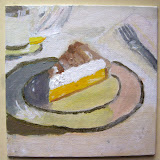
Sixth grade artists spent some time practicing watercolor techniques and then we looked at two contemporary watercolor artists, Sherri Reeve and Pauline Walsh Jacobson. Their undersea paintings capture the luminosity and movement that make watercolor and ocean paintings go so well together. Students selected a favorite fish or creature to draw and then copied it onto tracing paper from which they could replicate many times on their watercolor paper. For interest, they might borrow a fish from a classmate to add to their undersea composition. Then, we added fine lines in white crayon to the background in order to give the water a sense of movement. We added a wet on wet wash to the water, then carefully painted our fish. Finally, we added splatters of paint using a pipette to add an underwater "bubbling" effect.












